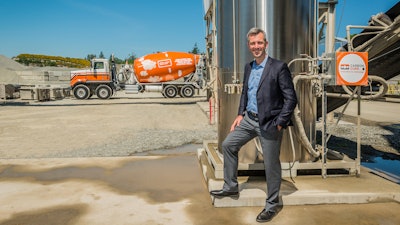
One of the levers of the Portland Cement Association's Roadmap to Net-Zero was on carbon capture and utilization. At the time, this concept was still relatively new for many. A lot of people had a lot of questions. For one, what is it? What does carbon capture technology look like? How much would it cost to install at the plant? What would the injection of CO2 into concrete do to the concrete?
Today, one of the leaders in carbon capture and utilization, CarbonCure Technologies, has announced that they have reached a significant milestone. It has saved more than 500,000 metric tons of carbon dioxide (CO2) to date. Tht's a half-million tons across 7.5 million truckloads of CarbonCure concrete.
 Central Concrete pouring CarbonCure concrete at UC Hastings in San FranciscoCarbonCure Technologies
Central Concrete pouring CarbonCure concrete at UC Hastings in San FranciscoCarbonCure Technologies
According to today's announcement:
“Surpassing 500,000 metric tons of CO2 savings illustrates the real progress CarbonCure has made in addressing the embodied carbon challenge of our built environment, forecasted to double by 2060, equivalent to building a new New York City every month,” said CarbonCure Board Chair Lisa Bate. “Corporations and governments are all seeking scalable solutions for lower carbon building materials, especially in the high growth data center and infrastructure segments. CarbonCure is meeting that demand and helping to pave the way for our net zero future.”
Half a million metric tons of CO₂ saved is equivalent to the carbon annually sequestered by 583,000 acres of middle-aged forestland – a forest that would cover roughly half of Grand Canyon National Park. It’s also equivalent to removing 119,000 gas-powered cars from the road for a year.
“This achievement simply would not be possible without the commitment and contributions of our forward-thinking industry partners,” Niven said. “It’s exciting to see the carbon removal and reductions delivered by CarbonCure translate into real value through high-integrity carbon credits, with CarbonCure’s shared credit revenue model incentivizing accelerated decarbonization of concrete production.”
 CarbonCure concrete at Amazon HQ2CarbonCure Technologies
CarbonCure concrete at Amazon HQ2CarbonCure Technologies
 IMI Concrete pours CarbonCure concrete at Infosys project in IndianaCarbonCure Technologies
IMI Concrete pours CarbonCure concrete at Infosys project in IndianaCarbonCure Technologies
What is Carbon Injection?
CarbonCure injects captured CO2 into fresh concrete where it immediately mineralizes, becomes permanently stored, and enables producers to use less cement while maintaining their concrete’s compressive strength. The solution is easily integrated into existing concrete plant operations, allowing producers to lower concrete’s carbon footprint without compromising performance. Producers also offset the technology costs with diversified revenue through reduced cement consumption and carbon credit generation. This combination of environmental and economic benefits has boosted CarbonCure’s global reach as the world’s most widely deployed carbon utilization solution for concrete decarbonization.


